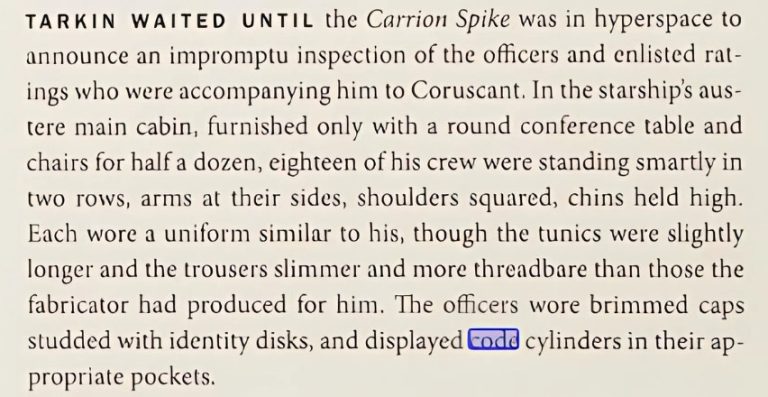I’ve seen a lot of people point at Thrawn’s uniform and ask why he’s walking around with four metal “pens” on his chest. The question shows up every time he appears, and I get why. They really do look like little writing tools. But once you dig into them, you start to see how much they say about Thrawn’s authority, his access, and the way the Empire builds its entire security system.
Let me walk you through it!
What Those “Pens” Really Are
When I first learned that those metal sticks are actually Imperial code cylinders, everything finally lined up. Canon material—like the Tarkin novel and the Visual Dictionaries—describes them as encrypted identity devices that carry the officer’s personal clearance data. They work through scomp links, the same kind of port astromechs plug into. The design shows up everywhere: A New Hope, Rogue One, Rebels, Obi-Wan Kenobi, The Mandalorian, and Andor.

I like thinking of them as an officer’s ID, login key, and access card combined. They hold coded identity info, they confirm rank, and they connect officers to secured systems. A code cylinder activates the door, the file, or the terminal only for the person it belongs to, which keeps the Empire’s structure clean and controlled.
Why Thrawn Carries More Than One
When I started paying closer attention, I noticed that officers don’t carry the same number of cylinders. That detail matters because every cylinder is tuned to specific sectors, each cylinder unlocks certain areas inside Imperial facilities or on ships. So if someone works in multiple sectors, they get multiple cylinders. It keeps everything separated inside a huge military network.
The Empire sets everything up this way for strict “need-to-know” control. Every installation is sliced into zones, and an officer needs the right cylinder to pass through each checkpoint. This prevents easy leaks, limits where each officer can go, and makes sure high-value areas aren’t unlocked by accident. Nothing overlaps unless the Empire wants it to, and cylinders are how they manage that.
This kind of setup also explains why rebels stealing one cylinder in Rebels or Andor doesn’t always give them complete access. They might get a window into a system, but only the exact one that cylinder was coded for.
After looking at different officers across the movies and shows, the pattern becomes easy to spot. Higher rank means more cylinders. Grand Moff Tarkin has four. General Tagge and Admiral Motti have three. Standard officers have one or two. The Official Star Wars Fact File 121 even mentions that Fleet Admirals carry three because they need access to capital-ship intelligence databanks.
Thrawn is a Grand Admiral. That position sits at the top of the Navy. His duties stretch across fleets, engineering projects, intelligence channels, and multiple systems. Carrying four cylinders lines up with the amount of work and oversight he’s trusted with.
Why They’re Worn Right on the Chest & Losing One Is Dangerous
One detail that stood out to me is that Imperial regulations expect officers to display their cylinders in plain view. It’s part of the uniform, and canon sources point out that the placement helps show authority without interrupting workflow. Everyone around knows a person’s clearance at a glance, and officers can step up to a scomp link without digging into a pocket.
Since cylinders link to one user, wearing them outside isn’t as risky as it looks. The device won’t treat someone else as the correct owner unless the thief knows how to bypass the system, which takes skill. In Rebels and Andor, infiltrators succeed because the story spends time showing how careful they need to be.
Another thing I found interesting is how severe the Empire’s rules are about damaging or losing a cylinder. Imperial sources explain that replacing one requires a lot of paperwork, and depending on the cylinder’s importance, losing it can be treated as a major offense. Some special cylinders are so sensitive that letting them fall into enemy hands can lead to charges as serious as treason.
This makes sense when you think about officers like Thrawn carrying several. Each one holds information that opens only the exact sectors he’s assigned. Losing a cylinder puts entire projects or intelligence networks at risk.
Fun Fact
The first appearance of Imperial code cylinders goes all the way back to Star Wars: Episode IV – A New Hope. During production, some of the cylinders on the officers’ uniforms were actually built from pen-like radiation dosimeters. The versions worn by Stormtrooper officers, shown later in Star Wars: The Visual Dictionary, were made from chalk holders supplied to researcher David West Reynolds by Mathew Clayson. These real-world items became the base for what ended up as one of the most recognizable parts of Imperial uniform design.

